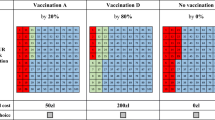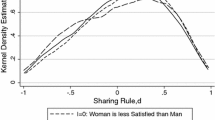Abstract
I derive values of marginal changes in a public good for two-person households, measured alternatively by household member i’s willingness to pay (WTP) for the good on behalf of the household, WTP i (H), or by the sum of individual WTP values across family members, WTP(C). Households are assumed to allocate their resources in efficient Nash bargains over private and common household goods. WTP i (H) is then defined by trade-offs between the public good and the household good, and WTP(C) by trade-offs of between the public good and private goods. WTP i (H) is found to be higher (lower) than WTP(C) when member i has a relatively high (low) marginal valuation of the public good, but tends on average to equal WTP(C). As a consequence, individuals tend to represent households correctly on average when questioned about the household’s WTP for a public good, even when they are purely selfish and answer truthfully. Adding all members’ WTP answers on behalf of the household then leads to double counting. Pure and paternalistic altruism (the latter attached to consumption of the public good) move each member’s WTP on behalf of the household closer to the true sum of individual WTP, but only paternalistic altruism raises this sum.
Similar content being viewed by others
References
Anderson S, Baland JM (2002) The economics of Roscas and intrahousehold resource allocation. Q J Econ 117:963–995
Aura S (2002) Does the balance of power within a family matter? The case of the retirement equity act. CESifo working paper no. 734
Bateman I, Munro A (2003) Non-cooperative decision–making and measures of household surplus. Working paper, University of East Anglia
Becker GS (1991) A treatise on the family, 2nd edn. Harvard University Press, Cambridge, MA
Bergstrom TC (1997) A survey of theories of the family. In: Rosenzweig M, Stark O (eds) Handbook of population and family economics, vol 1A. North-Holland, Amsterdam, pp 21–79
Bergstrom TC (2003) Benefit cost analysis and the entanglements of love. Working paper, University of California, Santa Barbara
Boyle KJ (2003) Contingent valuation in practice. In: Champ PA, Boyle KJ, Brown TC (eds) A primer on nonmarket valuation. Kluwer, Dordrect, pp 110–169
Browning M, Chiappori PA (1998) Efficient intra-household allocations: a general characterization and empirical test. Econometrica 66:1241–1278
Carson RT, Flores NE, Meade NF (2001) Contingent valuation: controversies and evidence. Environ Res Econ 19:173–210
Chen Z, Wooley F (2001) A cournot-nash model of family decision making. Econ J 111:722–748
Johansson PO (1994) Altruism and the value of statistical life: empirical implications. J Health Econ 13:111–118
Jones-Lee MW (1992) Paternalistic altruism and the value of statistical life. Econ J 102:0–90
Lundberg S, Pollak RA (1993) Separate spheres bargaining and the marriage market. J Polit Econ 101:988–1011
Lundberg S, Pollak RA (1997) Do husbands and wives pool their resources? Evidence from the United Kingdom child benefit. J Hum Res 32:463–480
Lundberg S, Pollak RA (2003) Efficiency in marriage. Rev Econ Household 1:153–167
Manser M, Brown M (1980) Marriage and household decision theory—a bargaining analysis. Int Econ Rev 21:21–34
McElroy M, Horney M (1981) Nash-bargained decisions: toward a generalization of the theory of demand. Int Econ Rev 22:333–349
Mitchell AC, Carson RT (1989) Using surveys to value public goods: the contingent valuation method. Washington, DC Resources For the Future
Munro A (2005) Household willingess to pay equals individual willingness to pay if and only if the household income pools. Econ Lett 88:227–230
Muthoo A (1999) Bargaining theory with applications. Cambridge University Press, Cambridge
Phipps SA, Burton PS (1998) What’s mine is yours? The influence of male and female incomes on patterns of household expenditures. Economica 65:599–613
Quiggin J (1998) Individual and household willingness to pay for public goods. Am J Agric Econ 80:58–63
Smith VK, van Houtven G (2004) Recovering Hicksian consumer surplus within a collective model: Hausman’s method for the household. Environ Res Econ 28:153–167
Author information
Authors and Affiliations
Corresponding author
Rights and permissions
About this article
Cite this article
Strand, J. Public-good valuation and intra-family allocation. Environ Resource Econ 38, 527–543 (2007). https://doi.org/10.1007/s10640-007-9098-3
Received:
Accepted:
Published:
Issue Date:
DOI: https://doi.org/10.1007/s10640-007-9098-3




